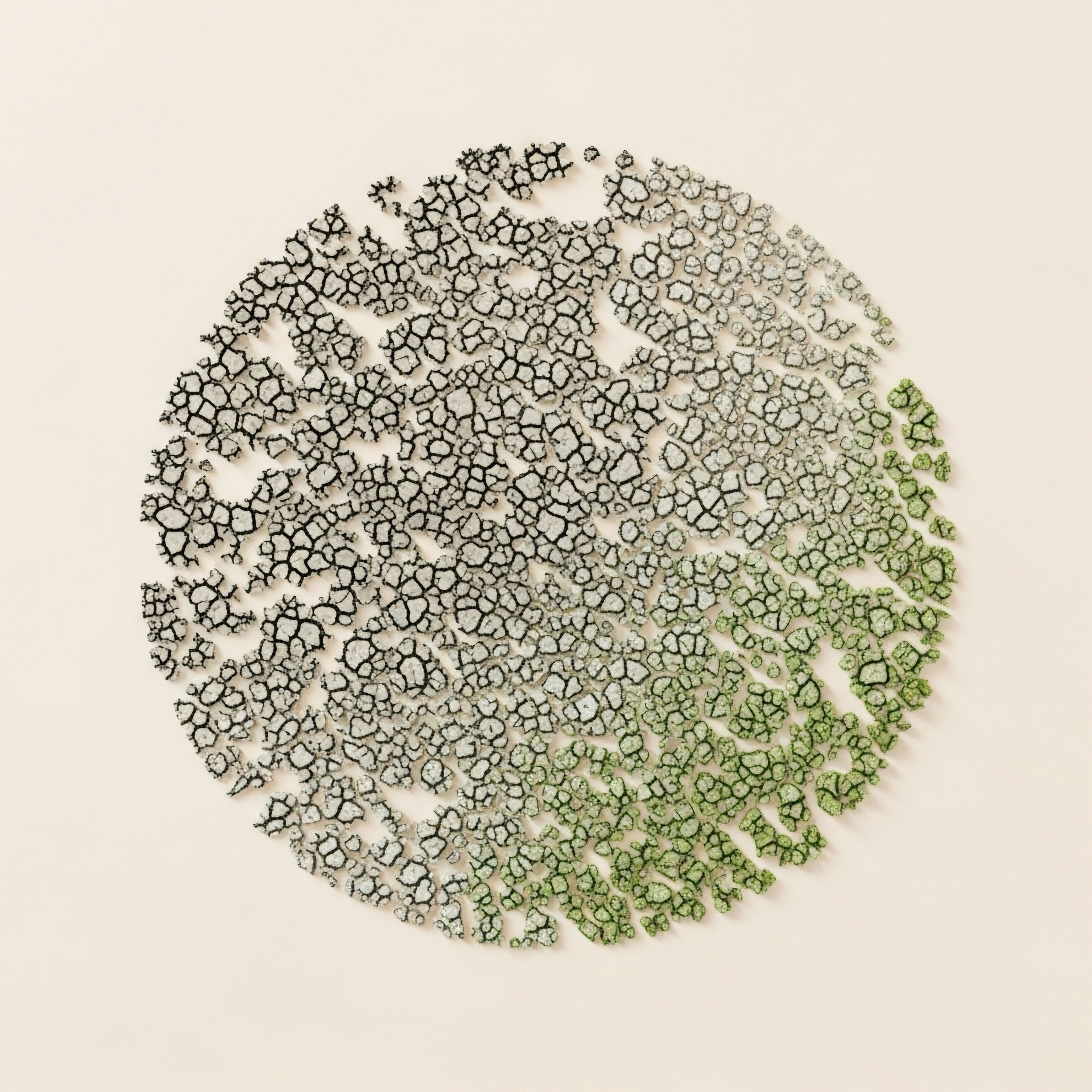

Fundamentals
When you experience persistent fatigue, a lingering sense of being unwell, or notice that your body simply does not recover as it once did from the demands of daily life or physical exertion, it is natural to seek explanations.
Perhaps you find yourself wondering why a minor injury seems to take an eternity to mend, or why your skin lacks its former resilience. These subtle yet pervasive shifts can feel deeply personal, signaling that something within your biological systems is operating below its optimal capacity.
Your experience is valid, and it points to a fundamental truth about human physiology ∞ our bodies are constantly engaged in a remarkable process of repair and renewal, a process profoundly influenced by the delicate balance of our internal chemical messengers.
The human body is a marvel of interconnected systems, and at the heart of its intricate communication network lies the endocrine system. This system comprises a collection of glands that produce and secrete hormones, which act as vital chemical messengers. These messengers travel through the bloodstream, delivering instructions to various cells and tissues throughout the body.
Think of hormones as the body’s internal messaging service, orchestrating everything from metabolism and mood to growth and, critically, the continuous process of tissue regeneration. When this messaging service experiences disruptions, the signals for repair and renewal can become distorted or diminished, leading to a cascade of long-term implications for cellular health.

The Body’s Constant Renewal
Tissue regeneration represents the body’s innate capacity to repair, replace, and restore damaged or aged cells and tissues. This process is not merely about healing from an injury; it is a continuous, dynamic activity that maintains the integrity and function of every organ system.
From the daily turnover of skin cells to the repair of muscle fibers after exercise, and the ongoing maintenance of bone density, regeneration is fundamental to vitality and longevity. Without efficient regenerative processes, tissues accumulate damage, lose functionality, and become more susceptible to decline.
Hormonal balance is essential for the body’s continuous repair and renewal processes.
The long-term implications of unaddressed hormonal imbalances on tissue regeneration are substantial. When the endocrine system’s delicate equilibrium is disturbed, the signals that prompt cells to divide, differentiate, and organize into healthy tissue are compromised. This can manifest in various ways, impacting the structural integrity and functional capacity of numerous bodily systems. Consider the foundational role of specific hormones in maintaining cellular health and driving regenerative pathways.

Hormonal Messengers and Cellular Health
Different hormones play distinct yet interconnected roles in supporting tissue health. For instance, testosterone, often associated with male physiology, is also vital for women, influencing muscle mass, bone density, and skin integrity. Growth hormone, another key player, directly stimulates cellular growth and repair.
Progesterone, primarily recognized for its role in female reproductive health, also possesses neuroprotective and anti-inflammatory properties that aid in tissue recovery. When these hormones are not present in optimal concentrations, the cellular machinery responsible for repair can falter.
The body’s ability to respond to injury or daily wear and tear relies heavily on the timely and appropriate release of these chemical signals. A sustained deficiency or excess of certain hormones can lead to a state where tissues are constantly attempting to repair themselves without adequate resources or instructions.
This creates a chronic deficit in regenerative capacity, potentially accelerating the aging process at a cellular level and contributing to a decline in overall physical function. Understanding these foundational connections is the first step toward reclaiming robust health.


Intermediate
Understanding the foundational role of hormones in tissue regeneration naturally leads to questions about how we can support these vital processes when imbalances arise. Personalized wellness protocols aim to recalibrate the endocrine system, providing the precise biochemical signals necessary for optimal cellular repair and systemic vitality. These interventions are not merely about symptom management; they are about restoring the body’s innate intelligence to heal and maintain itself.

Targeted Hormonal Optimization Protocols
Clinical interventions often involve specific hormonal optimization protocols designed to address deficiencies and restore physiological balance. These protocols are tailored to individual needs, considering factors such as age, gender, symptom presentation, and comprehensive laboratory analyses. The goal is to provide the body with the appropriate hormonal environment to facilitate robust tissue regeneration and overall well-being.

Testosterone Replacement Therapy for Men
For men experiencing symptoms of low testosterone, often referred to as andropause, testosterone replacement therapy (TRT) can be a transformative intervention. Symptoms such as diminished muscle mass, reduced bone density, persistent fatigue, and impaired recovery from physical activity often correlate with suboptimal testosterone levels. The standard protocol typically involves weekly intramuscular injections of Testosterone Cypionate (200mg/ml). This exogenous testosterone helps to restore circulating levels, providing the necessary signals for protein synthesis, bone remodeling, and muscle repair.
To maintain the body’s natural testosterone production and preserve fertility, a common addition to TRT is Gonadorelin, administered via subcutaneous injections twice weekly. Gonadorelin stimulates the pituitary gland to release luteinizing hormone (LH) and follicle-stimulating hormone (FSH), which are crucial for testicular function.
Another important component is Anastrozole, an oral tablet taken twice weekly, which helps to block the conversion of testosterone into estrogen, mitigating potential side effects such as gynecomastia or fluid retention. In some cases, Enclomiphene may be included to further support LH and FSH levels, offering an alternative pathway for testicular stimulation.
Personalized hormonal protocols aim to restore the body’s capacity for self-repair and vitality.

Testosterone Replacement Therapy for Women
Women also benefit significantly from testosterone optimization, particularly those experiencing symptoms related to pre-menopausal, peri-menopausal, or post-menopausal hormonal shifts. Symptoms like irregular cycles, mood changes, hot flashes, and decreased libido can be indicative of hormonal imbalances. For women, testosterone is typically administered at much lower doses, often 10 ∞ 20 units (0.1 ∞ 0.2ml) weekly via subcutaneous injection of Testosterone Cypionate. This precise dosing helps to support muscle tone, bone health, and cognitive function without masculinizing side effects.
Progesterone is another critical hormone for female balance, prescribed based on menopausal status. It plays a role in regulating menstrual cycles, supporting bone density, and promoting a sense of calm. For some women, pellet therapy, which involves the subcutaneous insertion of long-acting testosterone pellets, offers a convenient and consistent delivery method. When appropriate, Anastrozole may also be used in conjunction with pellet therapy to manage estrogen levels.

Growth Hormone Peptide Therapy
Beyond direct hormone replacement, peptide therapies offer another avenue for supporting tissue regeneration and overall metabolic function. These small chains of amino acids act as signaling molecules, influencing various physiological processes. Growth hormone peptides are particularly relevant for active adults and athletes seeking anti-aging benefits, muscle gain, fat loss, and improved sleep quality, all of which contribute to enhanced tissue repair.
Key peptides in this category include:
- Sermorelin ∞ A growth hormone-releasing hormone (GHRH) analog that stimulates the pituitary gland to produce and secrete more natural growth hormone.
- Ipamorelin / CJC-1295 ∞ A combination that also promotes growth hormone release, often favored for its sustained effect and minimal impact on cortisol levels.
- Tesamorelin ∞ A GHRH analog specifically approved for reducing visceral fat, which can indirectly improve metabolic health and reduce systemic inflammation, thereby supporting tissue health.
- Hexarelin ∞ A growth hormone secretagogue that can stimulate growth hormone release and has shown some cardioprotective effects.
- MK-677 ∞ An oral growth hormone secretagogue that increases growth hormone and IGF-1 levels, supporting muscle mass and bone density.
These peptides work by enhancing the body’s natural production of growth hormone, which is a powerful anabolic agent. Growth hormone directly stimulates cellular proliferation and differentiation, particularly in muscle, bone, and connective tissues. By optimizing growth hormone signaling, these therapies can accelerate recovery from injury, improve skin elasticity, and support the structural integrity of various tissues.

Other Targeted Peptides for Tissue Support
Specific peptides are also utilized for their direct effects on tissue repair and inflammation:
- PT-141 ∞ Primarily known for its role in sexual health, this peptide can influence neurological pathways related to desire and arousal.
While not directly regenerative, improved sexual health contributes to overall well-being and vitality, which supports systemic health.
- Pentadeca Arginate (PDA) ∞ This peptide is gaining recognition for its potential in tissue repair, healing, and inflammation modulation. PDA works by influencing cellular signaling pathways involved in wound healing and reducing inflammatory responses, which are critical for effective tissue regeneration. Chronic inflammation can significantly impede the body’s ability to repair itself, making anti-inflammatory interventions vital for long-term tissue health.
The application of these protocols represents a sophisticated approach to wellness, moving beyond a simplistic view of health to a systems-based understanding. By providing the body with the precise biochemical signals it requires, we can significantly influence its capacity for ongoing repair and regeneration, thereby mitigating the long-term consequences of hormonal imbalances.
| Hormone/Peptide | Primary Role in Tissue Regeneration | Clinical Application |
|---|---|---|
| Testosterone | Promotes protein synthesis, muscle growth, bone density, skin integrity. | TRT for men (Low T, andropause), TRT for women (peri/post-menopause symptoms). |
| Progesterone | Supports bone density, neuroprotection, anti-inflammatory effects. | Female hormone balance, particularly in peri/post-menopause. |
| Growth Hormone Peptides (e.g. Sermorelin, Ipamorelin) | Stimulate cellular proliferation, differentiation, collagen synthesis, fat metabolism. | Anti-aging, muscle gain, fat loss, improved sleep, accelerated recovery. |
| Pentadeca Arginate (PDA) | Modulates inflammation, supports wound healing, tissue repair. | Targeted healing, reduction of chronic inflammation. |


Academic
The long-term implications of unaddressed hormonal imbalances on tissue regeneration extend to the deepest levels of cellular and molecular biology. To truly grasp this complexity, we must consider the intricate interplay of biological axes, metabolic pathways, and cellular signaling. The body’s regenerative capacity is not a standalone function; it is inextricably linked to the precise orchestration of the endocrine system, which, when disrupted, can lead to a systemic decline in tissue integrity and function.

The Hypothalamic-Pituitary-Gonadal Axis and Regeneration
At the core of reproductive and anabolic hormone regulation lies the Hypothalamic-Pituitary-Gonadal (HPG) axis. This feedback loop involves the hypothalamus, which releases gonadotropin-releasing hormone (GnRH); the pituitary gland, which responds by secreting luteinizing hormone (LH) and follicle-stimulating hormone (FSH); and the gonads (testes in men, ovaries in women), which produce sex hormones like testosterone and estrogen.
A disruption at any point in this axis can lead to systemic hormonal imbalances with far-reaching consequences for tissue regeneration.
For instance, chronic stress can suppress hypothalamic GnRH release, leading to reduced LH and FSH, and subsequently, lower testosterone and estrogen levels. These sex hormones are not merely involved in reproduction; they are potent anabolic and anti-catabolic agents. Testosterone, for example, directly influences the activity of satellite cells in muscle tissue, which are crucial for muscle repair and hypertrophy.
It promotes protein synthesis and inhibits protein degradation, maintaining muscle mass and strength. Similarly, estrogen plays a vital role in bone remodeling, supporting osteoblast activity and inhibiting osteoclast-mediated bone resorption, thereby preserving bone density. When these hormonal signals are diminished over time, the body’s ability to repair and maintain musculoskeletal tissues is severely compromised, leading to sarcopenia and osteoporosis.

Metabolic Interconnections and Cellular Senescence
Hormonal imbalances are intimately linked with metabolic dysfunction, creating a vicious cycle that impairs tissue regeneration. Insulin resistance, often a consequence of chronic cortisol elevation or suboptimal thyroid function, can reduce the efficiency of nutrient uptake by cells, thereby limiting the building blocks available for repair.
Insulin-like Growth Factor 1 (IGF-1), a key mediator of growth hormone’s anabolic effects, is also influenced by insulin sensitivity. Reduced IGF-1 signaling directly impairs cellular proliferation and differentiation, which are fundamental steps in tissue repair.
Chronic inflammation, another common outcome of metabolic dysregulation and hormonal imbalance, further exacerbates the problem. Inflammatory cytokines can create a hostile microenvironment for regenerating cells, inhibiting their function and promoting cellular senescence. Senescent cells, often referred to as “zombie cells,” cease to divide but remain metabolically active, secreting pro-inflammatory molecules that damage surrounding healthy tissue and impair stem cell function.
Unaddressed hormonal imbalances can accelerate the accumulation of senescent cells, leading to a decline in tissue quality and regenerative capacity over time.
Chronic hormonal imbalances can accelerate cellular aging and impair the body’s repair mechanisms.

Molecular Mechanisms of Hormonal Influence on Regeneration
At a molecular level, hormones exert their effects by binding to specific receptors on target cells, initiating complex signaling cascades that regulate gene expression. For example, androgen receptors (AR) are widely distributed throughout the body, including in muscle, bone, and skin cells.
When testosterone binds to AR, it activates pathways that promote the synthesis of structural proteins, growth factors, and extracellular matrix components. A sustained lack of testosterone means these pathways are under-activated, leading to a gradual degradation of tissue architecture.
Growth hormone, through its primary mediator IGF-1, stimulates the mTOR pathway (mammalian target of rapamycin), a central regulator of cell growth, proliferation, and protein synthesis. Optimal growth hormone and IGF-1 signaling are essential for the repair of damaged tissues and the maintenance of cellular integrity. Conversely, deficiencies in growth hormone can lead to reduced protein turnover, impaired wound healing, and a diminished capacity for tissue remodeling.
Consider the role of peptides like Pentadeca Arginate (PDA). Research indicates PDA’s ability to modulate inflammatory responses and promote healing by influencing specific cellular pathways. For instance, it may interact with receptors involved in angiogenesis (new blood vessel formation) and fibroblast proliferation, both critical for wound closure and tissue reconstruction. The long-term absence of such supportive signals, whether from endogenous hormones or targeted peptide interventions, means that tissues are left vulnerable to cumulative damage without adequate repair mechanisms.
| Biological Axis/Pathway | Hormonal Influence | Impact on Tissue Regeneration |
|---|---|---|
| HPG Axis | Regulates sex hormones (testosterone, estrogen). | Directly affects muscle protein synthesis, bone remodeling, skin elasticity. Chronic imbalance leads to sarcopenia, osteoporosis. |
| Insulin/IGF-1 Signaling | Influenced by insulin sensitivity, growth hormone. | Controls cellular growth, proliferation, nutrient uptake. Impaired signaling reduces repair efficiency, promotes cellular senescence. |
| mTOR Pathway | Activated by growth hormone, IGF-1, amino acids. | Central to cell growth, protein synthesis, tissue repair. Suboptimal activation hinders recovery and maintenance. |
| Inflammatory Pathways | Modulated by sex hormones, cortisol, peptides. | Chronic inflammation creates hostile microenvironment, inhibits stem cell function, accelerates tissue degradation. |
The profound impact of unaddressed hormonal imbalances on tissue regeneration underscores the necessity of a systems-biology perspective. It is not simply about a single hormone being “low”; it is about the cascading effects across interconnected physiological systems, ultimately compromising the body’s fundamental ability to renew itself. Addressing these imbalances through precise, evidence-based protocols can recalibrate these systems, offering a pathway to restore cellular vitality and long-term tissue health.

References
- Mooradian, A. D. Morley, J. E. & Korenman, S. G. (1987). Biological actions of androgens. Endocrine Reviews, 8(1), 1-28.
- Veldhuis, J. D. & Bowers, C. Y. (2003). Somatotropin (GH) and Gonadotropin-Releasing Hormone (GnRH) Secretagogues ∞ Mechanisms of Action and Clinical Applications. Journal of Clinical Endocrinology & Metabolism, 88(3), 1011-1021.
- Riggs, B. L. & Melton, L. J. (2002). The worldwide problem of osteoporosis ∞ insights from epidemiology. Bone, 30(5), 651-654.
- Rosen, C. J. & Donahue, L. R. (2003). Insulin-like growth factor-I and bone ∞ the osteoporosis connection. Proceedings of the Society for Experimental Biology and Medicine, 228(10), 1159-1165.
- Boron, W. F. & Boulpaep, E. L. (2017). Medical Physiology (3rd ed.). Elsevier.
- Guyton, A. C. & Hall, J. E. (2016). Textbook of Medical Physiology (13th ed.). Elsevier.
- Traish, A. M. & Saad, F. (2017). Testosterone and the Aging Male ∞ A Practical Guide to Management. Springer.
- Miller, K. K. & Klibanski, A. (2007). Endocrine effects of growth hormone and IGF-I. Growth Hormone & IGF Research, 17(3), 177-183.
- Vance, M. L. & Mauras, N. (2001). Growth hormone therapy in adults and children. New England Journal of Medicine, 344(12), 886-895.
- Davies, M. J. & Metcalfe, J. C. (2003). Oxidative stress and damage in human disease. Journal of Clinical Investigation, 111(10), 1435-1437.

Reflection
As you consider the intricate dance of hormones within your own biological system, perhaps a new perspective on your health challenges begins to form. The journey toward understanding your body’s internal messaging service is not a passive one; it is an active exploration of your unique physiology.
Recognizing the profound impact of hormonal balance on your capacity for repair and renewal is the first step toward reclaiming vitality. This knowledge empowers you to ask deeper questions, to seek precise interventions, and to partner with clinical experts who can translate complex science into a personalized pathway for your well-being. Your body possesses an incredible capacity for healing, and by optimizing its internal environment, you can truly restore function and live without compromise.



